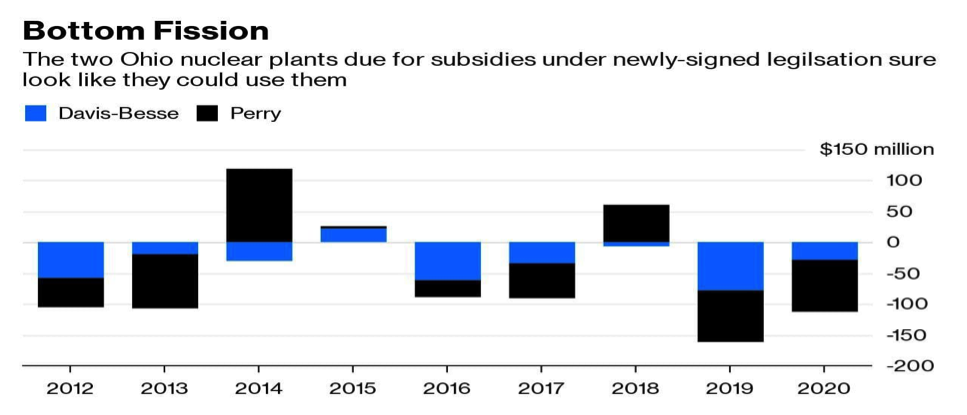Lawmakers in Ohio have chosen to rescue two existing nuclear plants and two existing coal plants in lieu of mandates on renewable energy and energy efficiency, and as a result, lower electricity prices are expected for electricity consumers. Renewable energy will have to enter the market on its own merits once renewable energy reaches 8.5 percent of electricity generated in the state—up from about 3 percent today—and once federal subsidies expire. Residential charges will be lowered by over $2.00 per month by the legislative change and grid reliability is expected to be enhanced. The Ohio bill is contrary to what most states are doing and it will be an interesting exercise to contrast future electricity prices here and in surrounding states that are continuing their renewable mandates and forcing new capital expenditures because of mandates and subsidies.
Nuclear
The new law in Ohio subsidizes two nuclear power plants. Residential customers will pay an 85-cent charge on their monthly bills and large industrial customers will pay up to $2,400. The surcharge will produce about $170 million a year; $150 million of that will be used to subsidize the two nuclear power plants—908 megawatt Davis-Besse, outside of Toledo, and 1,268 megawatt Perry, northeast of Cleveland, which will close within two years without the subsidy. The remaining $20 million will be divided between six existing solar projects in rural areas of the state. The subsidies are approved through 2026 and would total about $1 billion. The charge will start January 2021. Nuclear power accounts for 15 percent of the state’s energy generation and generates 85 percent of its carbon-free energy.
Regional grid operator, PJM, released a report in June concluding that keeping the Ohio nuclear plants running would reduce electricity costs by $95 million while reducing carbon dioxide emissions by 2.3 million tons.
According to Bloomberg NEF’s model, the two nuclear plants are projected to be $161 million in the red this year and have lost an average of $53 a million a year between 2012 and 2019.

Coal
Residential ratepayers will pay a monthly charge of $1.50 and large industrial ratepayers up to $1,500 to subsidize the Ohio Valley Electric Corporation’s two coal plants built in 1955, totaling $50 million a year. The two coal plants are the 1,300-megawatt Clifty Creek Generating Station on the Ohio River in Indiana, and the 1,086-megawatt Kyger Creek Generating Station in southeast Ohio. The subsidy will stay in place until 2030 and will help increase reliability to the grid. Coal accounts for 47 percent of Ohio’s electricity generation. Natural gas generators have replaced retiring coal plants, providing about a third of the state’s electricity.

Renewable Energy
Ohio has one of the oldest renewable portfolio standards in the country, requiring its utilities to get 12.5 percent of their power from renewables by 2027. The new bill reduces that percentage to 8.5 percent by 2026, ends the standard thereafter, and exempts large industrial customers. As noted above, solar will get about $20 million in subsidies as part of the new 85-cent charge to residential customers in addition to any federal subsidies. Eliminating existing renewable mandates is expected to result in lower electricity bills despite the new surcharge for Ohio’s nuclear plants. Renewable energy provides about 3 percent of Ohio’s electricity generation, but government-mandated increases necessitate capital outlays for new generation capacity, which according to IER’s recent study, cost more than existing sources of electricity.
Energy Efficiency
Ohio utilities are required to reduce customers’ energy use 22 percent from 2008 levels by 2027 through energy efficiency programs. The new bill allows utilities to abandon those programs entirely once they hit 17.5 percent, a level most have almost attained already. Through the new law, residential ratepayers could pay as much as $2.35 on their monthly electric bills for the nuclear, coal, and solar subsidies—less than the over $4.50 a month that they pay for Ohio’s renewable energy and energy efficiency mandates, which will end as early as next year. Thus, lawmakers believe this to be a rate reduction.
These new rates will be implemented in 2021. In the meantime, opponents are trying to get a potential referendum on the 2020 ballot. A referendum petition would require at least 1,000 signatures of Ohio voters to be certified by the Ohio Secretary of State and roughly 265,000 signatures to become a ballot issue.
Conclusion
Ohio’s new bill takes money away from renewable energy and efficiency mandates and directs it toward existing nuclear and coal plants, extending their operating lives. The bill reduces the monthly surcharges that were originally directed to renewable energy and energy efficiency programs. The bill is expected to lower electricity prices to consumers and increase reliability.
Much of this is in keeping with a recent Institute for Energy Research report that shows the levelized cost of existing technologies to be less than that of new technologies due to the fact that the capital component of cost has largely been paid for the existing plants. Existing coal and nuclear plants have been operating for 40 to 60 years and are able to continue producing electricity at lower cost than new plants, on average.



